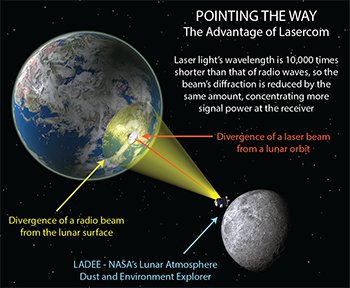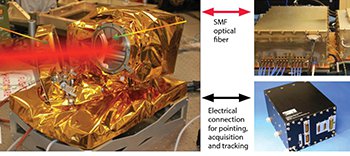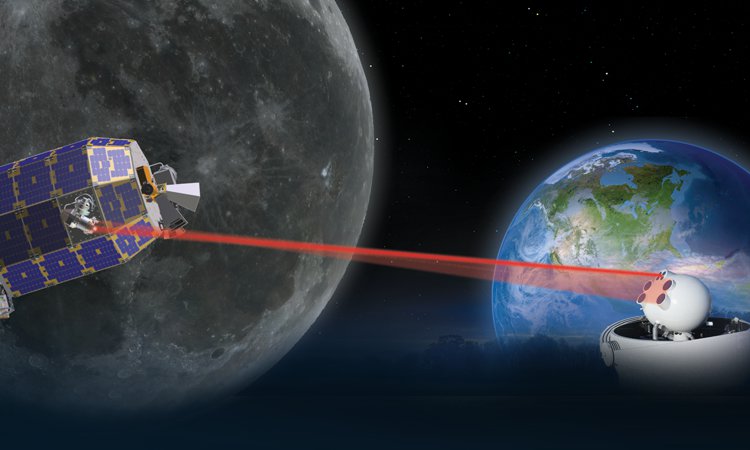 NASA’s first dedicated laser communication in space, the Lunar Laser Communications Demonstration (LLCD) Mission on NASA’s LADEE spacecraft in 2013, sent data across 400,000 km at a rate of 622 Mb/s. [NASA / Amber Jacobson]
NASA’s first dedicated laser communication in space, the Lunar Laser Communications Demonstration (LLCD) Mission on NASA’s LADEE spacecraft in 2013, sent data across 400,000 km at a rate of 622 Mb/s. [NASA / Amber Jacobson]
Laser communications through optical fibers move tens of terabits of data every second between cities and across oceans. But for the majority of Earth’s surface, where running fiber is impractical physically or financially, communication satellites in space provide connectivity—to remote ground users and also to mobile platforms such as aircraft, ships and even other satellites. These links rely on radio-frequency (RF) communications, which, while reliable, are orders of magnitude slower in moving data than optical fiber links, and have issues related to antenna footprint, power requirements and limited available spectrum.
The potential for the laser to overcome these issues in space was realized soon after its invention, although its special properties introduced new issues, such as the pointing and tracking of narrow beams over great distances while overcoming cloud cover, turbulence and other hurdles introduced by the atmosphere. Although the first laser communication systems were demonstrated in space in the 1990s, it is only recently that the technology, reliability and economics of photonic components have combined with the need for more bandwidth to push these systems more broadly into operation. The U.S. National Aeronautics and Space Administration (NASA) and the European Space Agency (ESA) are now deploying their first operational systems, which could pave the way for later commercial suppliers and, in future years, revolutionize communication both across the globe and across the solar system.
This article offers an update on recent developments and next steps in laser-based communications in space. It focuses especially on efforts at NASA, which—while a somewhat late entrant in this game—has lately shown rapid progress, culminating in a recent demonstration of a 622-Mb/s error-free data downlink from the moon to the Earth in 2013. More recently, NASA has been investigating new space-to-space and space-to-ground applications closer to Earth. In both realms, progress in terrestrial optical technology continues to push the limits of what can be done in space.
Illustration by Phil Saunders [Enlarge image]
An opportunity to move beyond radio
RF communications have become a bottleneck for moving data at Internet speeds in space. The centimeter-long wavelengths of microwaves in high-frequency RF transmission bands, such as Ka-band at 26 GHz, result in widely diffracting beams that spread over hundreds of kilometers on the Earth when transmitted over 39,000 km from a satellite above in geosynchronous orbit (GEO). Increasing data transmission to speeds in excess of 1 Gb/s require a more concentrated signal at the target, which for RF systems means transmission antennas larger than a meter to narrow the beam, and higher transmit powers to deliver the same energy per bit to the receiver. The spatial overlap among users of RF’s wide beams also means that RF users must acquire, and often pay for, a license for a specifically allocated frequency band to minimize interference. Competition for RF spectrum is fierce; licensing can be expensive and complex; and individual nations tend to view the RF spectrum in their territory as a “natural resource.”
Free-space optical communication (FSOC) using lasers offers the promise of breaking through that RF bottleneck. Laser transmitters, at wavelengths some 10,000 times shorter than RF waves, result in beams that are far narrower for the same unit aperture size—providing more concentrated communications power at the receiver with lower required transmitted power from smaller, lighter apertures. The upshot is a lower size, weight and power requirement for transmit and receive apertures of a laser communications terminal. Perhaps just as important, there is almost no spatial overlap among various users, so the FSOC optical spectrum is at present unregulated—a significant advantage for space-based users.
Yet FSOC also has its own distinct challenges. Signals from space to Earth need to cross mostly cloud-free zones, which raises questions about availability. Moreover, atmospheric turbulence can cause large and sudden drops of signal (or “fades”) that can last for many milliseconds, and may also require adaptive optics to improve coupling into single-mode fibers for high-bandwidth phase-sensitive detection. Perhaps most daunting, the extremely narrow divergence of the beams introduces challenges for their pointing, acquisition and tracking across the vast distances of space.
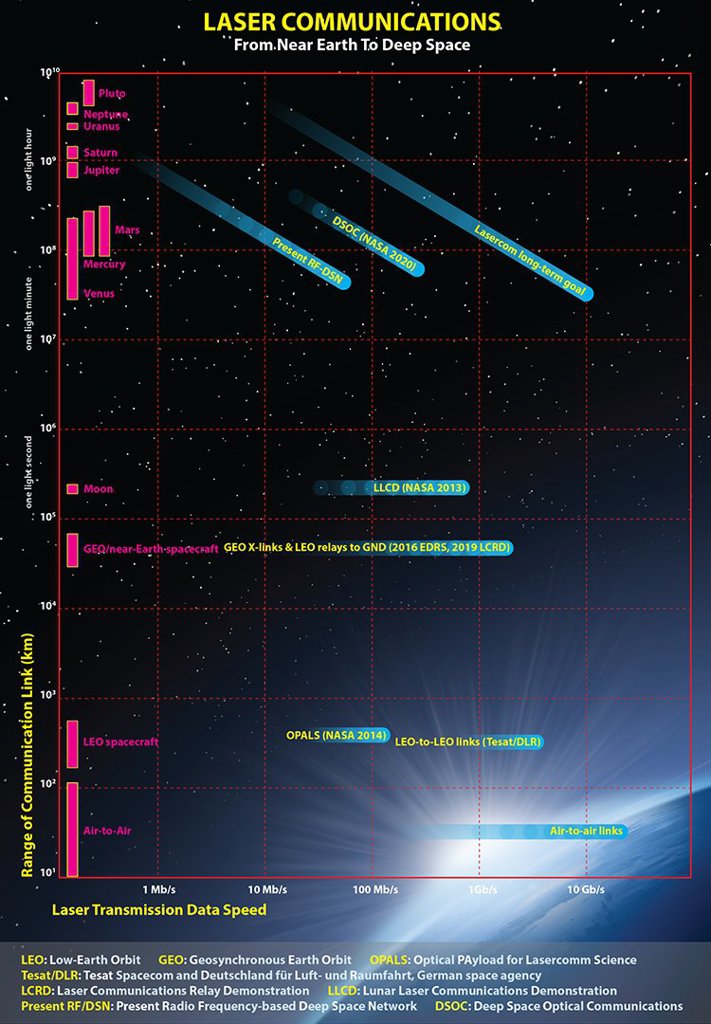
Illustration by Phil Saunders / Source: Don Boroson, MIT Lincoln Laboratory
Laser communication’s first steps in space
The first efforts in space-based laser communications, achieved by Japan and Europe, showed some success in overcoming these hurdles. Japan’s 1-Mb/s laser link to ground from the ETS-VI satellite in GEO in 1994—the first successful demonstration—was followed in 2001 by ESA’s SILEX/Artemis link demonstrations from GEO to ground and from GEO to low-Earth orbit (LEO). These initial experiments successfully demonstrated pointing, acquisition and tracking of narrow laser beams between spacecraft and directly to Earth stations, laying the groundwork for future systems in both Europe and Japan.
Development of FSOC flight systems continued in the early 2000s. The U.S. government launched the GEOLite laser communications mission in 2001. In 2008, the German Aerospace Center demonstrated a data rate of 5.6 Gb/s across 4,000-km crosslinks in space between its TerraSAR-X satellite and a corresponding terminal on the NFIRE spacecraft managed by the U.S. Department of Defense. Europe is now building on that experience to provide up to 1.8 Gb/s of laser-driven bandwidth to its Earth-observing Sentinel satellites in LEO, which will be the first operational laser communication users of the European Data Relay Satellite (EDRS) system, launching into GEO in 2016.
The economics of space laser communications changed significantly with the growth of terrestrial optical-fiber communications in the early 2000s.
The U.S. space agency has followed a more tentative path for laser communications in space. Although NASA initiated multiple efforts during the 1980s and 1990s, all were eventually cancelled due to growth in costs and the difficulty of obtaining reliable photonic components for use in space. But the economics of space laser communications changed significantly with the growth of terrestrial optical-fiber communications in the early 2000s, which suddenly boosted the availability of high-performance, low-cost components such as stable and efficient distributed-feedback (DFB) lasers, low-loss LiNbO3 modulators, and high-power and low-noise erbium-doped fiber amplifiers (EDFAs), all in the 1550-nm wavelength band. And the stringent environmental and reliability requirements of the Telcordia certifications, which govern terrestrial optical-communications equipment, are well-aligned with those for spaceflight.
From moon to Earth: NASA’s LLCD mission
NASA’s approach has been to leverage this Earth-based development for space, purchasing commercial components and, via rigorous space-qualification testing, moving them into new, reliable and lower-cost laser communications systems for both deep space and near Earth. Using that approach, NASA demonstrated its first laser communication system in space in 2013, with the Lunar Laser Communications Demonstration (LLCD) mission, aboard the Lunar Atmosphere Dust and Environment Explorer (LADEE). The mission broke new ground in a number of areas:
Longest-range dedicated optical communications link. LLCD demonstrated error-free data downlink rates of up to 622 Mb/s from the moon at a distance of some 400,000 km—ten times the range of earlier GEO-to-ground experiments, and thus overcoming a link loss that is 100 times greater. This included error-free operation through the turbulent atmosphere.
High data rates. LLCD was an order of magnitude higher in data rate than the best Ka-band radio system flown to the moon (100 Mb/s) on the 2009 Lunar Reconnaissance Orbiter.
High-definition video link. LLCD also demonstrated a 20-Mb/s uplink, which was used to transmit error-free high-definition video to and from the moon, a communication capability crucial to possible efforts to send humans beyond low-Earth orbit.
Pinpoint ranging. LLCD’s communication system provided simultaneous centimeter-class precision ranging to the spacecraft, which can be used to improve both spacecraft navigation and the gravity models of planetary bodies for science.
Low size, weight and power. LLCD’s space-based laser terminal required only half the mass (30.7 kg) and 25 percent less power (90 W) than the Lunar Reconnaissance Orbiter RF system (61 kg and 120 W, respectively).
The LLCD mission’s real breakthrough, however, was its demonstration that such a system could return real, high-value science data from the LADEE’s instruments as they probed the moon. The LLCD space terminal and primary ground terminal—both designed, built and operated by the Massachusetts Institute of Technology (MIT) Lincoln Laboratory—showed near-instantaneous laser link acquisition on every possible pass, followed by closed-loop tracking of the 15-microradian uplink and downlink beams. Data was imparted with pulse-position modulation (PPM) of an amplified single-frequency laser, then transmitted across the vast distance to the ground receiver through narrowband spectral filtering, in front of a state-of-the-art photon-counting detector. This device consisted of 16 superconducting nanowire detector arrays (SNDAs), and is so sensitive that only two received photons were required for every error-free bit detected.
SNDAs are also large enough to be efficiently coupled to a multimode optical fiber, which in turn is large enough to collect the signal spot—blurred due to atmospheric turbulence—at the telescope focus. Powerful error-correcting codes mitigated atmospheric scintillation or “signal fades,” as did a channel interleaver that partitions and distributes the “code words” in time on a scale much longer than the length of the fades, so that only a fraction of any given code word is lost. The code words are then re-assembled at the receiver, where the decoder finds and corrects the parts of the code word lost in the fade.
These techniques provided error-free data under a range of conditions, including through thin clouds, while LADEE and the moon were less than 5 degrees above the horizon—that is, through hundreds of kilometers of atmosphere—and even during daylight, while the LADEE spacecraft was within 3 degrees of the sun as seen from the ground station.
NASA’s LCRD Setup: (Left) LCRD optical module with 10.7-cm aperture, (right, top) LCRD multi-rate modem (MRM) with user rate from 2 Mb/s to 1.244 Gb/s (2.88 Gb/s uncoded) and (right, bottom) LCRD controller electronics module. [Enlarge image]
From demo to operation: The LCRD mission
The LLCD mission’s capabilities proved comparable to those of NASA’s venerable, RF-based Deep Space Network (see Optics & Photonics News, June 2014, p. 44), and provided a strong case for laser communications as a viable operational complement to the RF infrastructure. Unfortunately, however—by design—LLCD’s operations were limited to three months, and officially ended with the planned impact of the LADEE spacecraft on the moon in April 2014.
The next step for NASA will be a longer-term demonstration of FSOC in space, in the form of the Laser Communications Relay Demonstration (LCRD). Slated to fly as a hosted payload on a commercially built satellite launching in mid-2019, LCRD is designed to demonstrate high-bandwidth, bidirectional optical communications relay services between geosynchronous orbit (GEO) and Earth—and to develop and demonstrate reliable optical relay services from GEO over a time frame of two to five years.
The LCRD payload is currently being built at NASA’s Goddard Space Flight Center in Greenbelt, Maryland, USA. The payload consists of two independent laser communication terminals, which are connected via a new electronic switch to provide high-speed frame switching and routing between the two optical space terminals (OSTs) while also serving as the interface to the host spacecraft. Each OST, based on the MIT Lincoln Laboratory’s design for the earlier LLCD, includes a copy of an optical module with a gimbaled, inertially stabilized 10.7-cm telescope, along with a copy of the pointing, acquisition and tracking controller electronics, using commercially available equipment.
LCRD will also fly a new multi-rate modem (MRM) design to generate user data rates from 2 Mb/s up to 1.244 Gb/s via a differential phase shift-keyed (DPSK), burst-mode modulated beam at 1550 nm. And, as with LLCD, LCRD will leverage commercially available components from the optical fiber telecommunications industry: DFB master oscillator, high-power EDFA in the transmitter, low-noise EFDA preamp for the receiver, and many fiber-coupled optical isolators, wavelength multiplexers, filters and even monitor photodiodes.
Managing clouds and turbulence
To maximize availability due to cloud cover, the system will communicate with optical ground stations in two generally cloud-free zones—the NASA/Jet Propulsion Laboratory (JPL) telescope facility on Table Mountain, California; and the White Sands telescope facility near Las Cruces, New Mexico—with each station fully instrumented to characterize the local atmospheric stability and meteorological conditions.
The ground stations will be fitted with adaptive optics to actively compensate for atmospheric turbulence and to allow for coupling of the weak LCRD downlink signal into a single-mode optical fiber that will lead to the ground modem receiver. Unlike the LLCD demonstration, single-mode fiber is required, since demodulation of the DPSK signal through narrowband delay-line, Mach-Zehnder interferometric filters requires spatial coherence. Each ground modem will support full user-rate (1.244 Gb/s) duplex communications with the LCRD orbiting terminals; the received data will be delivered via optical fiber to the LCRD Mission Operations Center in White Sands for analysis.
LCRD’s goals over its multiyear operation are to measure and characterize the system performance across a variety of atmospheric conditions, while developing new software and operational procedures to adapt to them. These may include buffering data via the disruption-tolerant network (DTN) protocol for short outages, or performing fast handoffs between the two ground stations to mitigate longer outages due to passing clouds that might block the beam. The system will also provide an on-orbit capability to test and demonstrate new modulation schemes, as each modem is software defined and thus reprogrammable in orbit.
The culmination of the LCRD mission will be a demonstration of a “space relay” communications link from a spacecraft in low Earth orbit (LEO) up through LCRD in GEO and then down to the ground. Specifically, NASA is developing a new optical terminal to demonstrate on the international space station (ISS) in 2020 that is interoperable with LCRD for future space users in LEO or higher. This next-generation terminal will leverage recent developments in integrated photonics, which should reduce the size, weight, power and cost of the flight modem by an order of magnitude relative to RF systems. The new terminal may even replace the current LCRD terminal design for GEO if radiation requirements can be met.
If all goes according to plan, LCRD will allow service at data rates of up to 1.244 Gb/s to NASA’s next-generation Earth-orbiting scientific satellites. Those capabilities have positive implications not only for NASA but for other international space agencies and commercial space companies, which will receive access to the program as guest investigators.
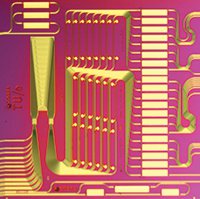
Integrated photonics in space communications
Powered by recent developments in nanostructures, metamaterials and silicon waveguides, integrated photonics could have a significant impact in the evolution of space-based laser communications. The lithographic techniques to create a photonic integrated circuit (PIC)—analogous to CMOS technology, but with photonic components replacing electrical traces—can realize hundred-fold reductions in size, mass, power and especially cost, because the PICs can be printed en masse. While PIC development is currently driven by the need for lower-footprint optical interconnects and transmission in data centers, their attributes are also critical to spreading free-space laser communications in the future.
NASA plans to place a PIC in the heart of its Integrated LCRD LEO User Modem and Amplifier (ILLUMA), leveraging access to custom device fabrication through the newly inaugurated AIM Photonics public-private partnership, sponsored by the DoD and currently managed by the State University of New York (SUNY). This technology should drive the eventual cost of the ILLUMA and other FSOC modems to well below that of today’s RF modems, allowing this technology to become ubiquitous in the space data links of the future.
(Above) PIC image courtesy of Photonic Integration Group, Eindhoven University of Technology
Lasers to deep space and beyond
The 2013 success of LLCD also provided new impetus to laser communications in another realm: deep space. NASA’s Space Technology directorate and Space Communications and Navigation (SCaN) program are now teaming to bring the agency’s Deep-Space Optical Communications (DSOC) effort to “Technology Readiness Level 6”—meaning a prototype unit fully ground-tested to space environmental levels, a.k.a., “shake and bake”—by the end of fiscal 2017, as a precursor to flight of a working laser communication system on the upcoming Discovery mission scheduled for 2020.
NASA JPL’s DSOC is designed to work from near-Earth asteroids out to Jupiter, and could deliver data at speeds of more than 250 Mb/s from Mars at opposition (0.42 AU, or 63 million km), while amounting to only 25 kg of mass and consuming only 75 W of power. But DSOC will face substantial additional challenges that LLCD did not—including a link that is 1,000 times farther from Earth, with a million times greater link loss; a required kilowatt-class uplink beam from the ground; development of a new photon-counting detector array on the spacecraft to see and locate that uplink beam; and the need for an order-of-magnitude improvement in inertially stabilized beam pointing and larger point-ahead angles for the downlink beam.
DSOC will also require larger receiver apertures on the ground than LLCD. NASA is studying development of a 12-m telescope for that purpose, though plans at present are to use the venerable 5-m Hale telescope on Mount Palomar to capture more than 100 Mb/s from Mars at opposition. Even that rate, however, constitutes an improvement of more than an order of magnitude from the highest RF data rate previously demonstrated from Mars—6 Mb/s from the Ka-band transmitter on the Mars Reconnaissance Orbiter. Hence, DSOC could constitute a profound shift in possibilities for the Mars science community.
Finally, commercial companies seeking to improve Internet bandwidth worldwide have a significant interest in FSOC. The governments of the world are leading the way on this technology by investing in the initial infrastructure while retiring the technical risks. If the promise of integrated photonics can truly be realized to drive the costs of FSOC to well below those of RF systems, then commercial networks of “fiber-in-the-sky” may soon follow, and lead to yet another communications revolution in the very near future.
Donald Cornwell is director of the Advanced Communications and Navigation Division within the Space Communications and Navigation Program, NASA Headquarters, Washington, D.C., USA.
References and Resources
-
K. Araki et al. “Performance evaluation of laser communication equipment onboard the ETS-VI satellite,” Photonics West 1996, pp. 52-59 (International Society for Optics and Photonics, 1996).
-
T. Tolker-Nielsen and G. Oppenhauser. “In-orbit test result of an operational optical intersatellite link between ARTEMIS and SPOT4, SILEX,” High-Power Lasers and Applications (International Society for Optics and Photonics, 2002).
-
H. Hemmati. “Interplanetary laser communications,” Opt. Photon. News 18(11), 22 (2007).
-
R. Fields et al. “NFIRE-to-TerraSAR-X laser communication results: Satellite pointing, disturbances, and other attributes consistent with successful performance,” SPIE Defense, Security, and Sensing, 73300Q (International Society for Optics and Photonics, 2009).
-
H. Hemmati et al. “Deep-space optical terminals (DOT),” SPIE LASE 2011, 79230C (International Society for Optics and Photonics, 2011).
-
B.L. Edwards et al. “Overview of the laser communications relay demonstration project,” Proc. Space Ops. 2012, 11 (2012).
-
D.M. Boroson et al. “Overview and results of the Lunar Laser Communication Demonstration,” SPIE LASE 2014, 89710S (International Society for Optics and Photonics, 2014).
-
N.W. Spellmeyer et al. “A multi-rate DPSK modem for free-space laser communications,” Proc. SPIE 8971, Free-Space Laser Communication and Atmospheric Propagation XXVI (March 25, 2014).

